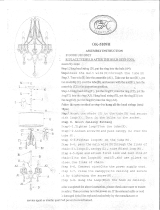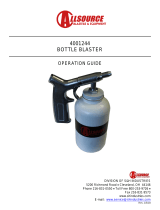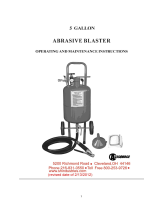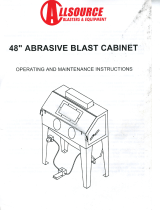Page is loading ...

DIVISION OF S&H INDUSTRIES
5200 Richmond Road Cleveland, OH 44146
Phone 216-831-0550 Toll Free 800-253-9726
Fax 216-831-9573
www.shindustries.com
E-mail: [email protected]
Rev. 1/5/18
40018
ABRASIVE BLASTER
OPERATING GUIDE

40018 Assembly Instructions
Page 2
WARNING!
Do not use an ALC Abrasive Blaster until you have read this manual and you understand its
contents and warnings. These warnings are included for the health and safety of the operator
and those in the immediate vicinity. Keep this manual for future reference.
Dust created by power sanding, sawing, grinding, drilling, and other construction activities
may contain chemicals known to cause cancer, birth defects or other reproductive harm and
respiratory illnesses. Some examples of the chemicals include:
Lead from lead based paints
Crystalline silica from bricks, cement and other masonry products
Arsenic and chromium from chemically-treated lumber
Your risk from these exposures varies, depending on how often you do this type of work. To
reduce your exposure to these chemicals: Work in a ventilated area, and work with approved
safety equipment, such as those dust masks that are specially designed to filter out
microscopic particles.
Abrasive blasting produces harmful dust. Everyone in the blasting area must wear a properly
fitted and properly maintained NIOSH-approved supplied-air respirator.
SILICOSIS AND OTHER DUST WARNINGS:
Breathing dust from silica sand may cause silicosis, a fatal lung disease. Breathing dust
during blasting operations may also cause asbestosis and/or other serious or fatal diseases.
A NIOSH-approved, well-maintained air-supplied abrasive blasting respirator must be used by
anyone blasting, anyone handling or using media containing toxic substances or media with
more than point one percent (.001) free crystalline silica and anyone in the area of the dust.
Harmful dust can remain suspended in the air for long periods of time after blasting has
ceased, causing serious injury or death.
Before removing respirator, use an air monitoring instrument to determine if atmosphere is
safe to breathe. Contact local OHSA or NIOSH office to determine the proper respirator for
your particular application.
Supplied-Air respirators do not remove or protect against carbon monoxide (CO) or any other
toxic gas. Use a carbon monoxide removal device and monitoring device with the respirator
to ensure grade D quality air. Follow all applicable OSHA standards and OSHA regulation
1910.134 (d).

40018 Assembly Instructions
Page 3
OPERATING GUIDE
APPLICATIONS
1. ABRASIVE BLASTING:
Your Abrasive blaster is designed to spray abrasive material such as black beauty, aluminum oxide, glass beads, metal shot,
silicon carbide, ground corncobs, and ground nutshells. The abrasive blasting of rust, paint, scale, grease, old paint, mold, mildew
and other corrosion from metal, wood, stone and fiberglass are ideal applications for the Sandy Jet blast cleaner. This product is
also excellent for etching distinctive designs in glass, wood, stone, marble and concrete.
ADDITIONAL WARNINGS!
CAUTION MUST BE EXERCISED BY USER AT ALL TIMES
1. Everyone in the blast area including the equipment operator should correctly use and
maintain a NIOSH-approved air-supplied respirator, even after blasting has ceased.
Harmful dust can remain suspended in the air for long periods of time after blasting has
ceased causing injury or death.
2. Before using the pressure blaster: Put on safety glasses, gloves, and NIOSH-approved
respirator. Always wear these protective items when operating and while servicing your
abrasive blaster. A well maintained air supplied blasting respirator must be used by
anyone blasting.
3. Use thick gloves with gauntlets to protect your hands.
4. Use backboards to prevent overspray from hitting someone or something else because
the dust will travel a long distance. Blast in a large open area to minimize abrasive
accumulation in surrounding areas.
5. For safe operation, perform recommended preventive maintenance on blaster tank,
remote unit and accessories. Replace all worn parts before they fail. Immediate
replacement of worn components is required. Failure to replace worn components
could result in exposing the operator or bystanders to high speed media and
compressed air, causing serious injury.
6. Do not use corrosive materials of any type in unit. Use only clean, dry media
7. Do not splice abrasive hose. The splice will wear out quickly and may violently spray
media over the surrounding area. A worn blast hose could suddenly fail by bursting.
Couplings and nozzle holders may not adequately grip worn hose, causing them to
blow off under pressure. Compressed air and abrasive escaping from a burst hose, or
disconnected coupling or nozzle holder, could cause severe injury.
8. Always place the machine so that the outlet is pointed away from any objects or
persons. Stand clear of the path of exiting abrasive. It may come out at high velocity.
Impact from exiting abrasive could cause severe injury.

40018 Assembly Instructions
Page 4
9. Static electricity can be created by the use of this equipment. Do not use within fifty feet
of any explosive, potentially explosive substances, or their vapors as an explosion can
occur.
10. Do not use this equipment in any area that might be considered hazardous or where
flammable gases or liquids are present. Failure to do so may cause an explosion
resulting in serious injury.
OPERATION
Connect your air supply to the handle of the blast gun with a 1/4" NPT fitting. Abrasive materials must be dry and preferably of the
finest grit available to prevent clogging of the gun.
The ALC abrasive blaster is designed to operate between 50–110 PSI. Pressures of no more than 70 PSI are recommended for the
etching of glass or plastic and the carving of wood. A minimum 2-3 HP compressor is required. At 80 PSI the 1/4" nozzle supplied with
the product will require 15 CFM. A smaller nozzle requiring only 7 CFM can be ordered separately. For maximum operating power, no
less than 5/16” I.D. air hose of a maximum 50 feet length with no splices or restrictions should be connected to a direct line from the
compressor tank to the blast gun.
When using an ALC container, note the air vent is located on the abrasive hose below the container. Keep it open at all times.
Abrasives must flow freely from container to the level part of hose below container. When using ALC Model 40018, slide suction hose
1-1/4" onto pick up aspirator tube, allowing 1/4” opening above outer tube for proper air venting.
The speed and quality of the blasting depends upon the size of the air jet and nozzle used, air pressure, type and size of abrasive, and
distance from the work surface. The gun should be held almost directly at the object to be cleaned, but at enough angle that the
abrasive doesn’t rebound at the operator. Abrasive power is increased as you hold the gun closer to the work. Make sure that your
abrasive material is dry.
WARNING!
Disconnecting hose while unit is under pressure could cause serious injury or death. Use
safety lock pins and safety cables in all coupling connections to help prevent hose couplings
from accidental disconnection.
If twist-on type air hose couplings are used, they must be secured by safety lock pins or wires
to prevent accidental disconnection while under pressure. Hose disconnection while under
pressure could cause serious injury.
WARNING!
The threads on the nozzle and nozzle holder must be inspected each time the nozzle is
secured to the holder. Check the threads for wear, and make sure nozzle holder securely
grips the nozzle. The nozzle washer must also be inspected for wear. Worn nozzle washers
cause thread erosion. A loose-fitting nozzle may eject from the holder under pressure and
could cause severe injury.
MAINTENANCE
Replace the nozzle when you notice too much air and abrasive or liquid escaping, or if cleaning speed is reduced. When the air jet is
worn, it will deflect the flow downward and will cut a groove in the nozzle. The ratio of wear is one air jet to every three or four steel
nozzles. If air jet and nozzle are not replaced when worn, the gun suction head will be damaged.
The nozzle is easily replaced by loosening the nozzle setscrew. The air jet is accessible by removing the suction head. To obtain
maximum power, the I.D. of the air jet must be 1/2 the I.D. of the nozzle. When re-assembling the blast gun, ensure that the suction

40018 Assembly Instructions
Page 5
head is holding the air jet and rubber sealing washer tightly against the gun body. Tighten the setscrew securely, making sure that it is
sitting in the proper groove on the gun handle. Also, periodically check the abrasive hose for leaks or cracks.
IMPORTANT: Nozzle and air jet must maintain proper size ratio, i.e. small/small, medium/medium, large/large.
WARNING
Abrasive particles and liquids are emitted from the blast gun under high pressure. Operator must wear
appropriate personal and respiratory protective equipment as approved by MSHA/NIOSH.
Abrasive (Media) Usage:
1. If moisture is in the media, it will eventually damage the blaster tank or plug the system. Keep the
media and compressor air dry to avoid this problem.
2. If the media is moist, screen it and dry it before using.
3. Do not leave media in the tank after blasting because it can absorb moisture and impair blasting
performance.
4. Store media in a dry place; keep media off the ground or concrete floors. Put it on a wooden skid.
5. It may not be advisable to blast if the humidity is excessively high.
6. Consider using different grades or different types of media to prevent nozzle clogging due to high
moisture content.
7. Do not use sand
ABRASIVE AND PRESSURE GUIDE
Material to Be Cleaned
Air Pressure
Abrasive
Grit Size
Steel vats
100-125 psi
Coal Slag
Garnet
30/50
20/40
Auto fenders
50-80 psi
Coal Slag
Garnet
80/120
20/40
Brick and block
80-125 psi
Coal Slag
Garnet
30/50
20/40
Steel cabinets
80-125 psi
Coal Slag
Garnet
30/50
20/40
Truck bodies
100-125 psi
Coal Slag
Garnet
30-50
20/40
Glass etching
50-70 psi
Glass beads
Aluminum Oxide
30/40
100
Wood
50-70 psi
Nut shells
Glass beads
14/30
30/40
Coal Slag #40093
Coal Slag is used when paint and rust has to be removed from steel, such as car bodies, tanks or
heavy machinery. Coal Slag is faster cutting, can be re-used, is moisture free, and will not pack or
absorb moisture. (25 Lb. container)
Steel Grit #40109

40018 Assembly Instructions
Page 6
Steel grit is extremely fast cutting on rusty metal and hard to remove paint. Steel Grit is popular
because it leaves a very smooth finish. It is also comparable in price to most other specialty
abrasives. Steel Grit is recommended in reclaim systems or cabinets. (25 Lb. container)
Glass Bead #40105
Glass Bead is used in creating a satin or matte finish. Glass Bead is recommended in reclaim
systems or cabinets. (25 Lb. container)
Aluminum Oxide #40098
Aluminum Oxide is a high quality abrasive that is sharper than sand (not recommended) and cuts
twice as fast as sand. It leaves a smooth textured finish with no pits or burrs. Aluminum Oxide is
rougher than glass bead and can be used over and over again. It is one of the most economical
abrasives you can use in any reclaim systems or cabinets. (4/25 Lb. container)
Plastic Grit #40110
Primarily used to strip aluminum and fiberglass. Great for stripping paint, light oxidation and surface
rust. Recommended for use in blast cabinets because it creates very little dust. Works quickly, last a
long time and increases visibility within the cabinet. (10 Lb. container)
Walnut Shells #40112
Walnut shells are recommended for use on “soft” surfaces such as aluminum, glass, wood, and other
areas where no pitting is desired. Leaves a smooth, dull finish. (10 Lb. container)

40018 Assembly Instructions
Page 7
TROUBLESHOOTING TIPS
PROBLEM/CAUSE POSSIBLE SOLUTION
Surging of blast flow:
Air pressure too low Check pressure gauge on compressor
Too much media
Excessive media consumption:
Media valve open too far Close slightly
Air pressure too low Check pressure gauge on compressor
Clogging and plugging of blast flow:
Debris in media Purge and screen
Media size too large Use smaller grit size
Nozzle plugs Use larger nozzle
Nozzle plugs Adjust media valve 40200
Wet media Dry media, drain water from air
Moisture in abrasive media:
Wet media Change or use dry media
Water in air Drain water from air lines
Water in tank Empty, dry out and refill
Humid weather:
Moderate humidity Keep media as dry as possible
Moderate humidity Use drier or moisture separator
High humidity Avoid that period of use if possible
Overtaxed compressor:
Compressor too small Restrict time used
Nozzle size too large Use smaller size
Too many leaks in plumbing Seal and tighten plumbing
Holes in abrasive hose Replace hose
Air filter on compressor plugged Clean
Lack of air pressure:
Compressor too small Use smaller nozzle
Supply valves not on full position Open valves
Nozzle size too large Use smaller size
Leaks in plumbing Seal and tighten plumbing
Holes in abrasive hose Replace hose
Air filter on compressor plugged Clean filter
Urethane gasket worn or dirty Clean or replace gasket
Lack of abrasive flow:
Blaster tank empty Fill tank
Moisture in media Dry media
Not enough air pressure Check system
Abrasive hose kinked Straighten hose
Debris in media Clean or screen media

40018 Assembly Instructions
Page 8
REPLACEMENT PARTS AND OPTIONAL ACCESSORIES
REPLACEMENT PARTS
Part No.
Description
40153
Blast gun body (equipped with 1/4” nozzle, 1/8” air jet)
40136
Blast gun handle only, with trigger and valve
40138
Blast gun siphon head only, with nozzle and air jet
40142
Washer
40144
Blast gun trigger
40145
Blast gun set screw
40146
Blast gun valve, spring and seat assembly
40147
Valve nut
40050
13/64” Steel nozzle (gold), 7 CFM @ 80 PSI
40051
1/4” Steel nozzle (silver), 15 CFM @ 80 PSI
40052
5/16” steel nozzle (black), 20 CFM @ 80 PSI
40047
5/64” Air jet (gold)
40048
1/8” Air jet (silver)
40049
5/32” Air jet (black)
40056
13/64” Ceramic nozzle, 7 CFM @ 80 PSI
40057
1/4” Ceramic nozzle, 15 CFM @ 80 PSI
40058
5/16” Ceramic nozzle, 20 CFM @ 80 PSI
40148
Allen wrench
40151
Pick-up tube assembly
40111
Abrasive hose (10 ft.) with straight end
40115
Abrasive hose (7 ft.) with molded elbow
40116
Abrasive hose (10 ft.) with molded elbow

40018 Assembly Instructions
Page 9
40018 ABRASIVE BLASTER ASSEMBLY INSTRUCTIONS
All parts for assembly will be found in parts bag inside of box

40018 Assembly Instructions
Page 10
BOX CONTENTS
Key
Part No.
Description
Qty.
Key
Part No.
Description
Qty.
A
10953
U-shaped bottom brace
1
L
Funnel end of tank
B
10951
Left upright arm
1
M
40688
Handle cap
2
C
10952
Right upright arm
1
N
4002100
Safety Goggles
1
D
11032
Tank
1
O
10181
¼-20 x 1½ Carriage Bolt
5
E
10956
Axle
1
P
10183
¼-20 Sq nut chamfered
7
F
40150
Hose ring
1
Q
10182
¼-20 x ½ RHMS
2
G
11034
Front tank support
1
R
4014800
Allen Wrench
1
H
40225
Wheels
2
S
10218
¼ USS Washer
2
I
10705
Hub cap
2
T
10705
Hub Cap
2
J
Hose
1
U
4002000
Open Face Hood
1
K
40149
Hose clamp
1
ASSEMBLY:
LEAVE ALL BOLTS LOOSE UNTIL STEP 5
1. Attach U-shaped brace (A) to left and right handles (B and C) using long bolts (O). Note: Brace
bolt hole in front must angle downward towards floor in back. Left and right handle bolt
holes must angle forward in toward tank (D) for proper assembly.
2. Insert axle (E) at one end only and hang hose ring (F) over axle end so ring will hang in center
between handles. Insert axle through second handle opening.
3. Attach tank (D) to handle uprights. Use two long bolts (O) and put washers (S) on inside of tank.
4. Install front tank support (G) using 2 short bolts (Q) on tank at top and one long bolt (S) on U-
shape brace at bottom. Bolt on bottom must angle downward from front to back (instruction No.
1).
5. Now, tighten all bolts.
6. Put wheels (H) on axle ends with long hubs inside and flat side of wheels to the outside.
7. Tap on hub caps (I) gently until seated.
8. Slip formed elbow of hose (J) through ring on axle. Hold hose clamp (K) on funnel end of tank (L)
with one hand and push hose over funnel end of tank.
9. Secure hose in position with hose clamp (K). Note: Hole near formed elbow in hose must be
kept open for proper operation.
See operating instruction sheet after assembly.

40018 Assembly Instructions
Page 11
Disclaimer of Warranties. S & H Industries, Inc. ("Seller") makes no warranties with respect to any
goods delivered to Buyer or users except as specifically set forth within this manual. S & H
INDUSTRIES, INC. MAKES NO IMPLIED WARRANTIES OF MERCHANTABILITY OR FITNESS
FOR A PARTICULAR PURPOSE WITH RESPECT TO ANY OF THE GOODS, AND S & H
INDUSTRIES, INC. EXPRESSLY DISCLAIMS ANY IMPLIED WARRANTIES AGAINST
INFRINGEMENT. S & H INDUSTRIES, INC. WARRANTIES SHALL NOT APPLY TO ANY DAMAGE
OR NON-CONFORMITY RESULTING FROM THE NEGLIGENT OF IMPROPER ASSEMBLY OR
USE OF ANY GOODS BY USERS OR BUYER OR ITS EMPLOYEES OR AGENTS, OR FROM
ALTERATION OR ATTEMPTED REPAIR BY ANY PERSON OTHER THAN S & H INDUSTRIES,
INC. ALL USED, REPAIRED, MODIFIED OR ALTERED ITEMS ARE PURCHASED AS-IS AND
WITH ALL FAULTS.
Indemnification Agreement. Buyer agrees, to the fullest extent permitted by the law, to fully
indemnify, hold harmless, and defend Seller, its parent, subsidiary, and affiliated companies, its
owners, officers, directors, employees, agents, representatives and insurers (collectively,
“Indemnities”) from and against any and all claims, demands, suits, damages, judgments of sums of
money, losses and expenses, including but limited to attorney’s fees and costs (collectively “referred
to herein as “Claims”) arising out of or resulting from any bodily injury, sickness, disease or death or
injury to or destruction of tangible property, arising out of or resulting from the use, sale or distribution
of any and all products purchased from Seller by Buyer, regardless of whether or not such claim
arises in whole or in part out of Seller’s alleged fault, including but not limited to Seller’s negligence,
strict liability, products liability, breach of warranty or any other act or omission. Buyer expressly
waives any and all immunity from suit by Seller, its parent, subsidiary, and affiliated companies, and
its owners, officers, directors, employees, agents, representatives and insurers, by operation of any
workers’ compensation law or statute. By purchasing from S & H Industries, Inc., Buyer
acknowledges and represents that Buyer has read, fully understands and agrees to the
Indemnification provisions set forth above.
LIMITED WARRANTY
S & H Industries Inc. warrants this product to be free from defects in materials or
workmanship for two years after the date of original purchase.
If the product should become defective within that warranty period, we will repair or replace it
(at our option) free of charge including return transportation to you provided you deliver it
prepaid to S & H Industries Inc., 5200 Richmond Road, Bedford Hts., Ohio 44146.
This warranty does not include damage resulting from accident, abuse or misuse of the
product. Nor does it apply to parts subject to abrasive wear, i.e., nozzles, air jets, seal blocks,
valves, hose connections and hoses.
Implied warranties including those of merchantability and fitness for a particular purpose are
excluded to the extent permitted by law, and any and all implied warranties are excluded. This
is the exclusive remedy and liability for consequential damages under any and all warranties
are excluded to the extent exclusion is permitted by law.
/





